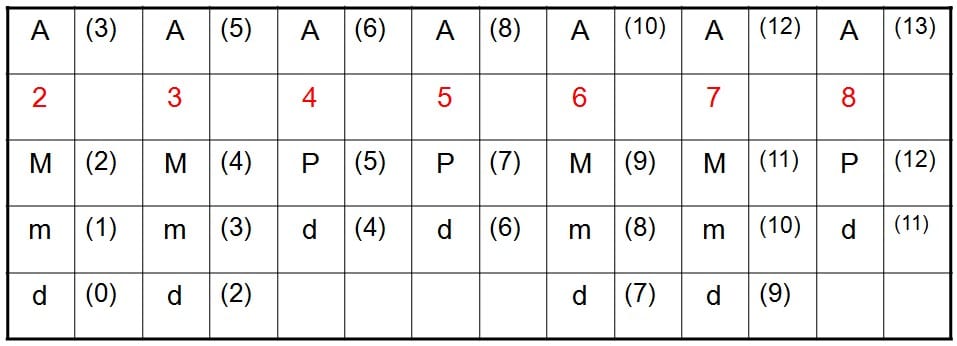In grade 4 you may be asked to describe the interval between two notes. The two notes will not be more than an octave apart. These notes may be from the major or minor scale set for this grade ie. up to five sharps or five flats. The lower note might not be the key note.
Intervals should always be counted from the lower note and may be described as harmonic or melodic. Harmonic intervals are so called when the higher note is directly above the lower note whereas an interval described as melodic would be when one note is played either before or after the lower note.


Interval chart
Use the following chart when working on interval questions.

The numbers in red are the intervals of a 2nd, 3rd, 4th, 5th, 6th, 7th & 8th. The intervals of 2nd, 3rd, 6th & 7th can be either major – shown with the capital ‘M’, minor shown with a lower-case ‘m’, diminished shown with a lower-case ‘d’ or augmented shown with a capital ‘A’. The intervals of a 4th, 5th or 8th can be either perfect shown with a capital ‘P’, diminished, shown with a lower-case ‘d’ or augmented, shown with a capital ‘A’. The bracketed numbers are the number of semitones that each of the intervals contain.
We will also be using a piano keyboard so it is important to know how to write out the keys, pay particular attention to the fact that there are no black notes between B & C and E & F.

Method:
Find the numbered interval of the two notes, always count from the lowest note. Using the keyboard count the number of semitones between the lower and higher note. Use the interval chart to provide the ‘quality’ of the interval e.g. Major 2nd, Augmented 5th.
If the numbered interval was ‘3’ and the number of semitones between the two notes were ‘2’ then the interval would be a diminished 3rd.
Remember:
When working out the numbered interval always count from the lowest note to the highest. We must also count the lowest note as ‘1’. When the numbered interval is found use the keyboard to count the number of semitones between the two notes.
Example 1:
When working out intervals find the ‘numbered’ interval first. Count the lowest note as ‘1’ and count up the positions of the stave to the higher note.


We then need to work out the ‘quality’ of the interval. Intervals may be described as MAJOR, MINOR, PERFECT, DIMINISHED or AUGMENTED. It may be of use to learn the following chart to help with this process.






